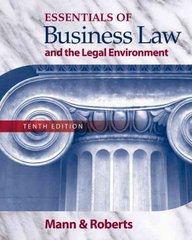Question
1. Download the cars.xlsx dataset from the course D2L shell.This dataset includes data on the 0-60 time (TIME), top speed (SPEED), curb weight (WEIGHT), and
1.Download the "cars.xlsx" dataset from the course D2L shell.This dataset includes data on the 0-60 time (TIME), top speed (SPEED), curb weight (WEIGHT), and horsepower (HP) of 30 automobiles.For full credit, in addition to providing your answers below, include your Excel spreadsheet with your scatter plot from a and regression output as part of your submission to the dropbox.
a.What is the expected effect of increasing horsepower on 0-60 time?
b.Using Excel, scatter plot of TIME (dependent variable, y-axis) and HP (independent variable, x-axis).Add a linear trendline to your scatter plot. Does your scatter plot confirm your prediction in (a)?
c.Estimate the regression TIMEi=0+ 1HPi+
d.Interpret your estimated coefficient on HP.(That is, in words, what does the value tell you?)Interpret the R2from your regression.
e.Estimate the regression TIMEi=0+ 1HPi+ 2WEIGHTi+
f.Interpret your estimated coefficient on WEIGHT.(That is, in words, what does the value tell you?)Does the sign of this coefficient match your expectations?What happened to the adjusted R2when WEIGHT was added to this regression?What does this tell you?
2.In an effort to determine whether going to class improved student academic performance, David Romer[1]developed the following equation:
Where:Gi= the grade of the ith student in Romer's class (A=4, B=3, etc).
ATTi= the percent of class lectures that the ith student attended
PSi= the percent of the problem sets that the ith student completed
a.What signs do you expect for the coefficients of the independent variables in this equation?Explain your reasoning.
b.Romer then estimated the equation:
Do the estimated results agree with your expectations?
c.It's usually easier to develop expectations about the signs of coefficients than about the size of those coefficients.To get an insight into the size of the coefficients, let's assume that there are 25 hours of lectures in a semester and that it takes the average student approximately 50 hours to complete all of the problem sets in a semester.If a student in one of Romer's classes had only one more hour to devote to class and wanted to maximize the impact on his or her grade, should the student go to class for an extra hour or work on problem sets for an extra hour?Explain your answer. (HINT:Convert the extra hour to percentage terms and then multiply those percentages by the estimated coefficients.)
d.From the given information, it would be easy to draw the conclusion that the bigger a variable's coefficient, the greater its impact on the dependent variable.To test this conclusion, what would your answer to part c have been if there had been 50 hours of lecture in a semester and if it had taken 10 hours for the average student to complete the problem sets?Were we right to conclude that the larger the estimated coefficient the more important the variable?
e.What's the real world meaning of R2= 0.33?For this specific equation does 0.33 seem high, low or about right?
f.Is it reasonable to think that only class attendance and problem set completion affect your grade in a class?If you could add just one more variable to the equation, what would it be?Explain your reasoning.What should adding your variable to the equation do to R2? To adjusted-R2?
[1]Romer, David.(1993).Do Students Go to Class?Should They?Journal of Economic Perspectives7(3): 167-74.

Step by Step Solution
There are 3 Steps involved in it
Step: 1

Get Instant Access to Expert-Tailored Solutions
See step-by-step solutions with expert insights and AI powered tools for academic success
Step: 2

Step: 3

Ace Your Homework with AI
Get the answers you need in no time with our AI-driven, step-by-step assistance
Get Started


